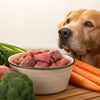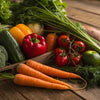How Much Raw Food for a 100 lb Dog: Crafting the Perfect Diet
- Houndsy
Table of Contents
- Introduction
- Understanding Raw Dog Diets
- How Much Should a 100 lb Dog Eat on a Raw Diet?
- Transitioning Your Dog to a Raw Diet
- Nutritional Balance in Raw Diets
- Monitoring Your Dog's Health on a Raw Diet
- FAQs about Raw Dog Diets
- Conclusion
Introduction
Did you know that a staggering 60% of dogs in the United States are classified as overweight or obese? As responsible pet parents, it’s our duty to ensure our furry companions receive a balanced and healthy diet, a vital component in maintaining their well-being. With an increasing number of us exploring raw dog diets, it’s crucial to understand one pressing question: how much raw food should you feed a 100 lb dog?
This comprehensive guide will delve into the raw dog feeding landscape, including the benefits of a raw diet, how portion sizes are determined, essential nutritional components, and transition tips to make this shift smooth for your pet. By the end, you’ll have a clear understanding of how much raw food is perfect for your larger canine companion, along with insights that can enhance your dog feeding routine.
As we embark on this journey, we invite you to reflect on your current dog feeding practices and think about how a raw diet might fit into your lifestyle and your pup's health needs.
Understanding Raw Dog Diets
What is a Raw Dog Diet?
A raw dog diet is often referred to as the BARF diet—Biologically Appropriate Raw Food or Bones and Raw Food. This diet advocates for feeding dogs uncooked animal parts, including muscle meat, bones, and organ meats, closely resembling their ancestral dietary habits. The goal of this diet is to bring dogs back to nature, aligning their nutrition with what their wild ancestors would have consumed.
The Benefits of a Raw Diet
Switching to a raw diet can offer numerous benefits for dogs of all sizes. A few key advantages include:
- Improved Digestion: Raw food tends to be more digestible for dogs, leading to fewer gastrointestinal issues.
- Healthier Skin and Coat: Owners often report shinier coats and healthier skin after switching their dogs to raw diets.
- Weight Management: A raw diet can facilitate achieving and maintaining a healthy weight since it typically contains fewer fillers than traditional kibble.
- Better Dental Health: Chewing on raw bones helps reduce plaque and tartar buildup, promoting good dental hygiene.
- Increased Energy Levels: Many pet owners observe a notable boost in their dog's energy levels post-transition to raw foods.
Considering these benefits, it's essential to approach raw feeding thoughtfully and informed.
How Much Should a 100 lb Dog Eat on a Raw Diet?
Determining the right portion of raw food for a larger dog, like one weighing around 100 lbs, hinges on several factors, including:
- Activity Level: An active dog may require more food compared to a less active companion.
- Age: Puppies and younger dogs typically need more food than seniors.
- Health Concerns: Dogs with specific health conditions may require tailored feeding strategies.
General Guidelines
A crucial guideline in raw feeding suggests providing 2-3% of your dog’s ideal body weight per day. For a 100 lb dog, this translates to approximately:
- 2 to 3 lbs of raw food daily.
We understand this can seem daunting, but remember, these figures are starting points—every dog is unique, and their nutritional needs will vary.
Breakdown of Daily Raw Food Portions for a 100 lb Dog
| Portion Size | Food Amount (Daily) |
|---|---|
| Minimum (2%) | 2 lbs |
| Average (2.5%) | 2.5 lbs |
| Maximum (3%) | 3 lbs |
So, in practical terms, a 100 lb dog should ideally consume between 32 oz to 48 oz (2 to 3 lbs) of raw food each day. These recommendations can guide you but should be adjusted according to your dog's individual health and lifestyle needs.
Special Considerations
- Weight Management: If your pup is on the heavier side, starting towards the lower end of this range—and monitoring them closely—might be best to promote weight loss.
- Puppies vs. Adults: Puppies require more raw food, about 4-6% of their current body weight, highlighting the importance of understanding the age of your dog while determining portions.
- Activity Level: Highly active dogs may benefit from slightly higher food intake.
Let’s delve deeper into how to successfully transition to a raw diet while ensuring adequate nutritional balance.
Transitioning Your Dog to a Raw Diet
Gradual Transition
Transitioning your dog to a raw food diet should be a gradual process to avoid any digestive upset. To smoothly introduce new food:
- Days 1-3: Mix 25% raw food with 75% of the current diet.
- Days 4-6: Adjust to a 50/50 mix of raw food and traditional food.
- Days 7-10: Increase the ratio to 75% raw and 25% old food.
- Day 10 and beyond: You can fully transition to a raw diet.
Observing your dog during this transition is critical. Look for any signs of upset stomach, such as diarrhea or vomiting. If issues arise, consider slowing down the transition process further.
Monitoring Your Dog's Health
Regular check-ins on your dog’s health during this phase are crucial. Keep track of their weight and physical condition, noting any adverse reactions or improvements in energy levels and overall health. Consult your veterinarian, especially if there are concerns regarding the new diet.
Nutritional Balance in Raw Diets
Key Components of a Balanced Raw Diet
Creating a nutritionally complete raw diet requires attention to key components:
- Muscle Meat: This is the primary source of protein.
- Organ Meat: Supplies vital vitamins and minerals.
- Raw Meaty Bones (RMBs): Excellent for calcium and phosphorus.
- Vegetables and Fruits: While not strictly necessary, they can add fiber and additional nutrients.
- Supplements: Omega-3 fatty acids or probiotics may be beneficial, particularly if you're preparing meals at home.
Adopting the 80/10/10 Rule
A popular guideline among raw feeders is the 80/10/10 rule, which suggests that a balanced diet should ideally consist of:
- 80% muscle meat
- 10% bone
- 10% organ meat (with liver accounting for half of this)
Following this guideline can help ensure that your dog receives a well-rounded diet to stay healthy.
Monitoring Your Dog's Health on a Raw Diet
Regular Weigh-Ins
To keep your dog in good shape on a raw diet, schedule regular weigh-ins. You should be able to feel their ribs without excess fat and see a waistline when looking from above. Adjust portions as needed based on these observations.
Professional Consultation
Always consult your veterinarian before making substantial dietary changes. If you observe unusual health concerns or require tailored dietary advice, the expertise of a vet can be invaluable.
FAQs about Raw Dog Diets
-
Is it safe to feed my dog raw meat? Yes, feeding raw meat is generally safe, provided it is sourced from reputable suppliers and handled correctly. Dogs' strong stomach acids help them process certain bacteria.
-
Can puppies eat raw food? Absolutely! Puppies can begin consuming raw food as they start weaning. It's important to cater their nutrition to their unique developmental needs.
-
What if my dog is picky about raw food? If your dog has a selective palate, gradually introducing raw food or mixing in flavors they enjoy can encourage consumption.
-
How do I balance a raw diet? Following the 80/10/10 rule and consulting a vet can ensure your dog receives a complete nutritional profile.
-
What if I can’t afford raw food? If cost is a concern, consider homemade raw meals or mixing raw food with kibble to provide balanced nutrition without breaking the bank.
Conclusion
Understanding and determining how much raw food to feed a 100 lb dog is crucial for their health and longevity. By comprehensively grasping the nuances of raw feeding, monitoring your dog’s health closely, and consulting professionals when needed, you can significantly enhance your pup's quality of life.
At Houndsy, we are passionate about simplifying and elevating the feeding experience for you and your furry companion. Our Houndsy Kibble Dispenser is designed to streamline and beautify your dog feeding routine, ensuring perfect portions without the hassle. It not only offers practical functionality with its stylish mid-century design, but it also aligns with our mission to enhance pet well-being through quality and convenience.
Ready to take the next step for your dog's health? Explore the Houndsy Kibble Dispenser and redefine your dog feeding experience today!












